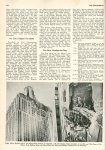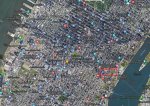ENGINE 21 FIREHOUSE 238 E 40TH STREET MIDTOWN EAST MANHATTAN DIVISION 3, BATTALION 8 “THE 21 CLUB”
TURTLE BAY - MIDTOWN EAST
Turtle Bay is a neighborhood in New York City, on the east side of Midtown Manhattan. It extends from roughly 43rd Street to 53rd Streets, and eastward from Lexington Avenue to the East River's western branch (facing Roosevelt Island).[4][5][6][7][8] The neighborhood is the site of the headquarters of the United Nations and the Chrysler Building. The Tudor City apartment complex is to the south of Turtle Bay.[9]
Turtle Bay is named after a former cove of the East River, which in turn was named after the Dutch word for "knife". The neighborhood was originally settled as a Dutch farm in the 17th century, and was subsequently developed with tenements, power plants, and slaughterhouses in the 19th century. These industrial structures were largely demolished in the 1940s and 1950s to make way for the United Nations headquarters. Today, Turtle Bay contains multiple missions and consulates to the nearby United Nations headquarters.
Turtle Bay is part of Manhattan Community District 6, and its primary ZIP Codes are 10017 and 10022.[1] It is patrolled by the 17th Precinct of the New York City Police Department.
Turtle Bay, Manhattan - Wikipedia
HISTORY, TURTLE BAY
How the Manhattan neighborhood of Turtle Bay got its name
POSTED ON FRI, JANUARY 26, 2018
BY EMIL
The Manhattan neighborhood of Turtle Bay, a stretch of Midtown East that holds everything from skyscrapers to brownstones, has a history dating back to 1639. Modern-day New Yorkers might envision the area got its name from “hundreds of turtles sunning themselves on the rocks along the East River between 45th and 48th Streets,” as Ephemeral New York puts it. Back then, that’s where an actual bay was once located in Colonial-era Manhattan, surrounded by meadows, hills and a stream that emptied at the foot of today’s 47th Street. Some historians do think actual turtles lent to the neighborhood name, as they were plentiful in Manhattan at the time and were commonly dined on. But another reading of history suggests oth
Turtle Bay, an actual cove of the East River, received its name back in the 17th century by Dutch settlers. As the story goes, the cove was shaped like a knife, so the settlers named it “deutal,” which is Dutch for “a bent blade.”
The neighborhood of Turtle Bay begins in 1639, with a 40-acre land grant given to two Englishmen by the Dutch colonial governor of New Amsterdam. The farm extended roughly from what is now 43rd Street to 48th Street, and from Third Avenue to the river. The Englishmen named the plot “Turtle Bay Farm.” Here’s where historians think the name was more likely a corruption of the Dutch word “deutal” rather than a reference to actual turtles in the bay.
Back then, the area filled with farms, houses and villas surrounding by picturesque hills and streams. But after the street grid system was initiated in Manhattan, the hilly landscape of Turtle Bay Farm was graded to create cross-streets. Between 1840 and 1850, the land was subdivided for more formal residential development.
But the name stuck as the area changed. According to the
Turtle Bay Association, from its early days as a settlement through the Revolutionary War, the bay offered sailing ships a safe haven from winter gales and the capricious currents of the East River, making it important to the commerce of Manhattan. Shipbuilders established a thriving business there. And by the time Robert Fulton tested his steamboat on the East River in 1808, the wharf was teeming with breweries, carpentry shops, mills and industrial business.
Development of the neighborhood grew after the streets were gridded, but it really took off after the Civil War. Upon the war ending, the building of brownstones ultimately transformed the scenic landscape. The bay was filled in, and the waterfront became “a commercial sinkhole,” according to the Turtle Bay Association. “By 1868, the beautiful bay was filled in, its charms sullied by slaughterhouses, packing sheds, cattle pens, rotting wharfs, and railroad piers,” the organization says.















































